Mandible
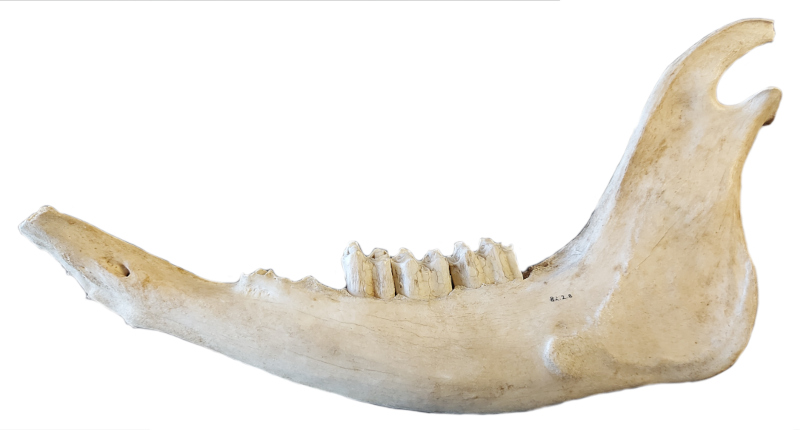
The presence or absence and condition of teeth are ignored for the purpose of bone unit analysis. For the Oldman Dam Project, the condition of loose mandibular dentition is coded as weathered, and bone unit for loose teeth is coded as indeterminate.
For the Fincastle Project, Bone Units 51-52 were added.
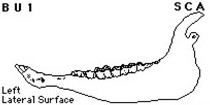
BU 1
SC A
Complete element.
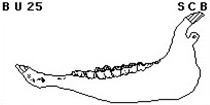
BU 25
SC B
Element complete except for 1-3cm of the proximal end of the coronoid process, which has apparently been removed by crushing.
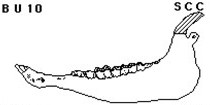
BU 10
SC C
Element complete except for coronoid process.
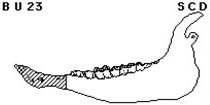
BU 23
SC D
Unit consists of element with symphyseal surface and incisor alveoli removed.
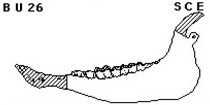
BU 26
SC E
Element with coronoid process and anterior section in front of P-2 containing the interalveolar border, canine tooth, and the incisor teeth removed.
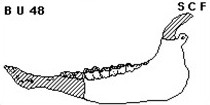
BU 48
SC F
Similar to BU 26, with the exception that the section of the mandible anterior to the M1 is missing. Unit otherwise consists of the condylar process, ascending ramus, angle, and mandibular body posterior to the M1. (TVH)
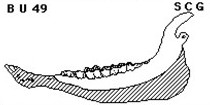
BU 49
SC G
Unit consists of a portion of the row of cheek teeth, with attached parts of the coronoid and condylar processes. Similar to BU 23, but without the ventral border of the body. (WU)
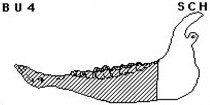
BU 4
SC H
Complete proximal portion of mandible. Includes coronoid process, articular condyle, and entire ascending ramus; usually severed from rest of mandible immediately behind cheek teeth. Rarely, will include M3. Similar to BU 11.
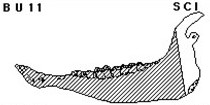
BU 11
SC I
Consists of coronoid process, articular condyle and posterior half of ascending ramus. Most of dorsal and superior margin of ascending ramus absent. The portion of the angle of the mandible present on BU 11 exhibits slight to marked evidence of crushing. BU 11 and BU 4 are similar in form.
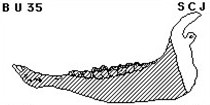
BU 35
SC J
Consists of complete coronoid process, complete articular condyle, and major portion of ascending ramus. The angle of the mandible may or may not be present. Most of the dorsal margin of the ascending ramus is absent. Similar to BU 11 except it lacks crushing.
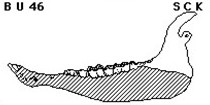
BU 46
SC K
Complete articular condyle, coronoid process, all or most of ascending ramus to upper portion of angle of mandible present. The unit has either been severed from the remainder of the element immediately behind the M3 or it may include the M3. Similar to BU 2 and BU 38. (KK)
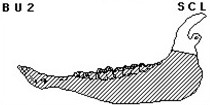
BU 2
SC L
Proximal ½ or less of ascending ramus including complete coronoid process and articular condyle. Similar to BU 27.
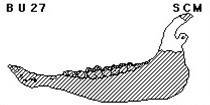
BU 27
SC M
Proximal ½ or less of ascending ramus including complete articular condyle and portion but not all of coronoid process. Similar to BU 2 and BU 3.
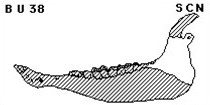
BU 38
SC N
Complete articular condyle; coronoid process missing; all of ascending ramus to upper portion of angle of mandible present. The unit has either been severed from the remainder of the element immediately behind the M3; or it may include the M3. If the M3 is present, the horizontal ramus and portion of the angle of the mandible below it is absent. (JB)
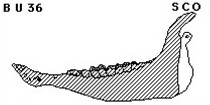
BU 36
SC O
Consists of articular condyle and major portion of ramus. The angle of the mandible may or may not be present. Most of dorsal margin of ascending ramus is absent. Similar to BU 16 but lacks crushing.
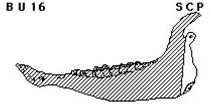
BU 16
SC P
Unit consists of articular condyle and posterior half of ascending ramus. All or most of dorsal and superior margin of ascending ramus absent. The portion of the angle of the mandible present evidence clear signs of crushing. Similar to BU 36.
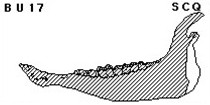
BU 17
SC Q
Unit consists of all of or most of posterior edge of articular condyle and portion of angle of mandible. No evidence of crushing. Similar to BU 11 and BU 16.
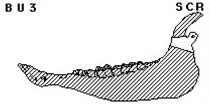
BU 3
SC R
Proximal ½ or less of ascending ramus including articular condyle. Coronoid process absent. Similar to BU 27.
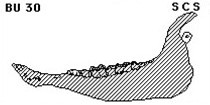
BU 30
SC S
Complete articular condyle with 0-10cm of adjoining ascending ramus. Coronoid process absent. Similar to BU 32. (EMA)
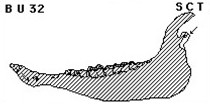
BU 32
SC T
Fragment of articular condyle with from 0-10cm of adjoining ascending ramus present. Coronoid process absent.
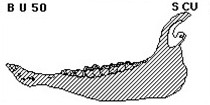
BU 50
SC U
Unit consists of the small “U” –shaped fragment for the juncture of the condylar and coronoid processes, with attached small portions of the ascending ramus. Anterior posterior borders of the ramus are removed. Similar to BU 27. (TVH)
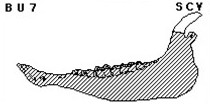
BU 7
SC V
Consists of essentially complete coronoid process. Similar to BU 29 and BU 31.

BU 40
SC W
Complete coronoid process plus up to ½ of adjoining surface of ascending ramus. Articular condyle absent. (KK)
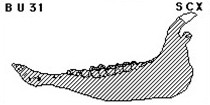
BU 31
SC X
Tip of coronoid process. One half or less of superior portion of process represented. (DS)
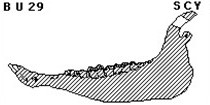
BU 29
SC Y
Medial fragment from coronoid process. Tip missing. (JB)
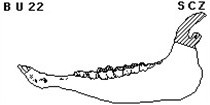
BU 22
SC Z
Element complete except for coronoid process, articular condyle and proximal portion of ascending ramus.
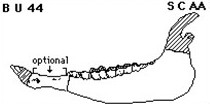
BU 44
SC AA
Element complete except for proximal portion of ascending ramus and incisor alveoli. Symphyseal surface and interalveolar border may also be absent. Similar to BU 5, BU 22 and BU 42. (KK)
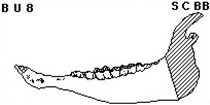
BU 8
SC BB
Consists of entire portion of the mandible anterior to ascending ramus. Includes all of cheek teeth, interalveolar border, symphyseal surface and incisor alveoli. Similar to BU 42.
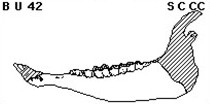
BU 42
SC CC
All of mandible anterior to ascending ramus except incisor alveoli. Similar to BU 5 and BU 8. (KK)
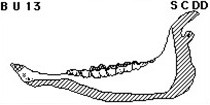
BU 13
SC DD
Cheek teeth and most of dorsal edge of ascending ramus. Posterior margin of ascending ramus and ventral margin of horizontal ramus removed. All of the interalveolar edge and all or part of incisor alveoli present. Similar to BU 12.
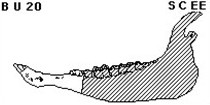
BU 20
SC EE
Consists of all or most of symphyseal surface; all or most of alveoli for incisors; all of interalveolar border, and all or part of premolar section of tooth row. Ventral margin essentially intact. Similar to BU 6, BU 20 and BU 21. Teeth may or may not be in, socketed or intact.
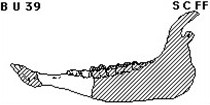
BU 39
SC FF
Portion of interalveolar border with adjoining portion of premolar section of tooth row. Does not include symphyseal surface or alveoli for incisors. (TH)
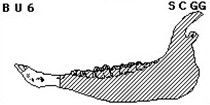
BU 6
SC GG
Consists of all or most of symphyseal surface, all or most of alveoli for incisors and usually much or all of the interalveolar border. Similar to BU 20.
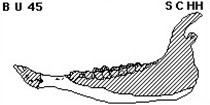
BU 45
SC HH
Ventral portion of mandible extending from interalveolar border to angle of mandible. A portion to all of interalveolar border represented. Similar to BU 15. (KK)
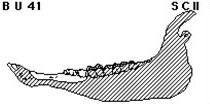
BU 41
SC II
All or portion of interalveolar border. May include one or two premolars. Ventral border absent. (KK)
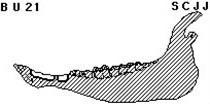
BU 21
SC JJ
Small fragment of mandible characterized by presence of portion of interalveolar border. Frequency indicates minimum number of elements.
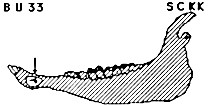
BU 33
SC KK
Fragment of anterior portion of mandible identified by presence of all or part of mental foramen. Only the lateral aspect of the piece is present. The medial surface is absent. None of the interalveolar border, or ventral margin is represented. (DS)
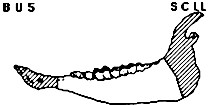
BU 5
SC LL
Complete section of cheek teeth severed from rest of mandible. Ventral margin intact. May include anterior edge of angle of mandible. Includes none of ascending ramus. Similar to BU 8 and BU 42.
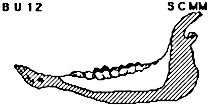
BU 12
SC MM
Cheek teeth and most of dorsal edge of ascending ramus. Posterior margin of ascending ramus and ventral margin of horizontal ramus removed. Proximal portion of interalveolar edge may be present.
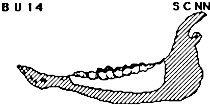
BU 14
SC NN
Socketed section of cheek teeth with small portions of interalveolar ridge sometimes present. Ventral margin absent and either extreme proximal and/or distal tooth may occasionally be absent.
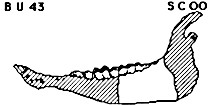
BU 43
SC OO
Large portion of the horn and attachment to the skull. (SB)
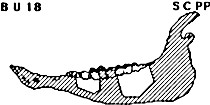
BU 18
SC PP
Unit consists of fragmented portion of row of cheek teeth. Unit may consist of only fragment characterized by presence of empty tooth sockets; or complete or fragmentary teeth may still be present. Unit should represent no more than 3 teeth of entire tooth row. Inferior margin always absent. Note: Frequency indicates number of pieces only.
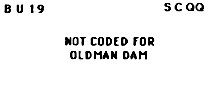
BU 19
SC QQ
Minimum number of elements represented by BU 18. Not coded for Oldman dam.
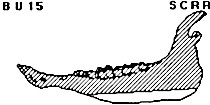
BU 15
SC RR
Section of ventral margin of horizontal ramus. Frequency indicates minimum number of elements represented. For Oldman project, frequency indicates number of pieces only. Similar to BU 45.
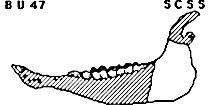
BU 47
SC SS
Complete angle of mandible with adjoining portions of ascending ramus and body. Similar to BU 9, BU 28 and BU 38. (WU)

BU 9
SC TT
Small to medium sized fragment of angle of mandible. Entire angle of mandible not represented. Similar to BU 28.
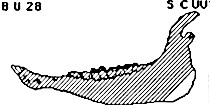
BU 28
SC UU
All of angle of mandible with only a limited portion of margin of ascending and horizontal ramus. Similar to BU 9.
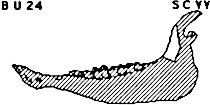
BU 24
SC VV
Unit consists of small to medium sized fragment of mandible characterized by presence of dorsal margin of ascending ramus.
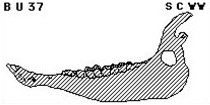
BU 37
SC WW
Fragment characterized by presence of all or part of mandibular foramen. Coronoid process, articular condyle, dorsal and ventral margins of ascending ramus, angle of mandible are totally absent. (DS)
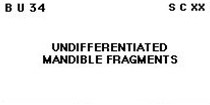
BU 34
SC XX
Undifferentiated mandible fragments. Generally fragments from ascending or horizontal ramus containing no landmark features. (DS)
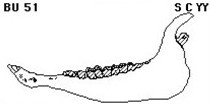
BU 51
SC AAA
Element mostly complete, missing the articular condyle. (SB)
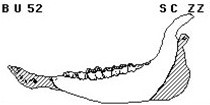
BU 52
SC BBB
Consists of the coronoid process, portions of ascending ramus, cheek section with teeth, missing articular condyle and distal end of mandible. (SB)